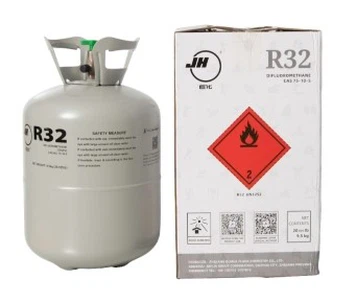
The global HVAC industry is rapidly evolving, with R32 refrigerant gas emerging as the leading solution for modern air conditioning systems. As environmental regulations tighten and energy efficiency becomes a top priority, R32 gas has gained significant traction, especially in Southeast Asia, the Middle East, and Europe. If your business is involved in refrigerant exports, understanding why gas R 32 dominates the market in 2025 is crucial.
What Makes r32 freon the Preferred Refrigerant?
Higher Energy Efficiency (10% Better Than R410A)
R32 freon outperforms older refrigerants like R410A refrigerant with 10% greater energy efficiency, reducing electricity consumption in air conditioners. This is a major selling point for manufacturers and end-users, especially in regions with high cooling demands like India and the Middle East.
Lower Global Warming Potential (GWP = 675)
Compared to R410A gas (GWP 2,088), R 32 gas has a significantly lower environmental impact (GWP 675). While not as eco-friendly as R290 (propane, GWP 3), it remains a balanced choice for countries transitioning away from high-GWP refrigerants.
Single-Component Refrigerant (Easier to Recycle & Reuse)
Unlike R410A (a blend of R32 and R125), R32 refrigerant is a single-component refrigerant, making it easier to recover, purify, and reuse. This reduces waste and operational costs for HVAC technicians.
Global Market Demand for R32 in 2025
🔥 Surging Exports to Southeast Asia & the Middle East
China exported over 10,000 tons of R32 in 2024, with Thailand, Vietnam, and Saudi Arabia as top buyers.
India's AC market is growing at 15% annually, driving massive R32 demand.
⚠️ EU Regulations & Future Restrictions
The EU F-Gas Regulation is pushing for refrigerants with GWP < 750 by 2026, making R32 a short-to-medium-term solution.
Germany and France are already shifting to R290 (propane), but R32 remains dominant in commercial ACs.
📈 Price Trends & Supply Chain Factors
R32 refrigerant price rose by 20% in early 2025 due to supply shortages and rising demand.
Why Should Refrigerant Exporters Focus on R32?
Easier Transition for Manufacturers
Most R410A-based AC systems can be retrofitted to use R32 gas with minimal modifications, making adoption smoother.
Strong Demand Until 2030 (Despite Future Bans)
Although the GWP of R32 is still higher than the EU limit of 150 after 2030, under current technical conditions, it has an irreplaceable intermediate value compared with natural working fluids such as R290 and CO₂:
R290: GWP=3.3, but the high flammability of A3 class limits its application in household scenarios.
CO₂: GWP=1, but the high-pressure system (10MPa) causes the equipment cost to increase by 2-3 times, and the performance of low-temperature working conditions fluctuates greatly.
Therefore, R32 refrigerant not only meets the current emission reduction needs, but also reserves space for future technology iterations.
R32 is Still the Best Short-Term Solution
R32 has become the mainstream choice in the current global air-conditioning industry due to its comprehensive advantages of policy compliance, performance advantages, safety and controllability, and industrial maturity. Its market position will be difficult to shake before 2029. With technological progress and policy support, R32 will gradually complement natural working fluids and jointly promote the zero-carbon transformation of the refrigeration industry.







